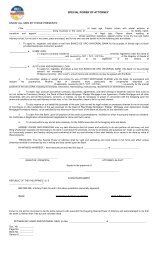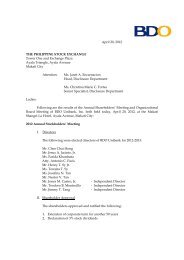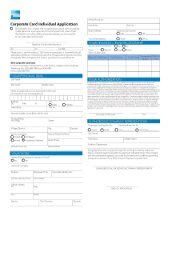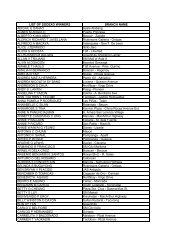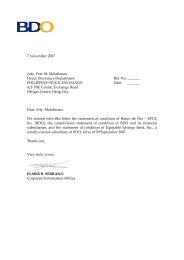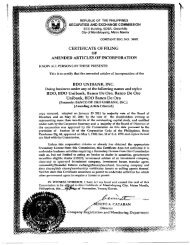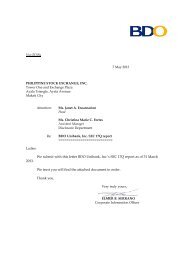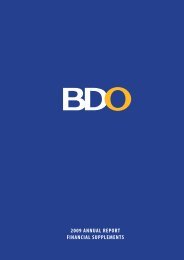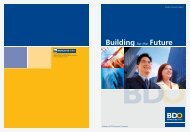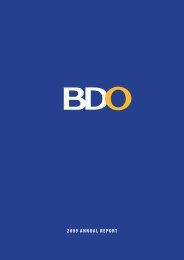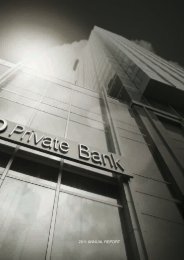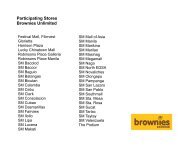Notes to Financial Statements - BDO
Notes to Financial Statements - BDO
Notes to Financial Statements - BDO
You also want an ePaper? Increase the reach of your titles
YUMPU automatically turns print PDFs into web optimized ePapers that Google loves.
<strong>Notes</strong> <strong>to</strong> <strong>Financial</strong> <strong>Statements</strong>DECEMBER 31, 2008, 2007 AND 2006(Amounts in Millions Except Per Share Data)Subsidiaries are all entities over which the Group has the power <strong>to</strong> govern the financial and operating policies generally accompanying ashareholding of more than one-half of the voting rights. The existence and effect of potential voting rights that are currently exercisable orconvertible are considered when assessing whether the Group controls another entity. Subsidiaries are fully consolidated from the date onwhich the Group obtains control. They are de-consolidated from the date that control ceases.Associates are all entities over which the Group has significant influence but not control, generally accompanying a shareholding of between20% and 50% of the voting rights.In the Parent Bank financial statements, the investments in subsidiaries and associates are carried at cost, less impairment in value.2.10 Premises, Furniture, Fixtures and EquipmentPremises, furniture, fixtures and equipment are carried at acquisition cost less accumulated depreciation and amortization and any impairmentin value. Property items of the former EPCIB stated at appraised values were included in the Group balances at their deemed costs at dateof transition <strong>to</strong> PFRS on January 1, 2005. The revaluation increment is credited <strong>to</strong> Revaluation Increment account in the Equity section, net ofapplicable deferred income tax.The cost of an asset comprises its purchase price and directly attributable costs of bringing the asset <strong>to</strong> working condition for its intendeduse. Expenditures for additions, major improvements and renewals are capitalized; expenditures for repairs and maintenance are charged <strong>to</strong>expense as incurred. When assets are sold, retired or otherwise disposed of, their cost and related accumulated depreciation and amortizationand impairment losses are removed from the accounts and any resulting gain or loss is reflected in income for the period.Depreciation is computed on straight-line basis over the estimated useful lives of the depreciable assets as follows:BuildingsFurniture, fixtures and equipment10 <strong>to</strong> 50 years3 <strong>to</strong> 5 yearsLeasehold rights and improvements are amortized over the terms of the leases or the estimated useful lives of the improvements, whicheveris shorter.An asset’s carrying amount is written down immediately <strong>to</strong> its recoverable amount if the asset’s carrying amount is greater than its estimatedrecoverable amount (see Note 2.21).The residual values and estimated useful lives of premises, furniture, fixtures and equipment are reviewed, and adjusted if appropriate, at eachstatement of condition date.An item of premises, furniture, fixtures and equipment is derecognized upon disposal or when no future economic benefits are expected <strong>to</strong>arise from the continued use of the asset. Any gain or loss arising on derecognition of the asset (calculated as the difference between the netdisposal proceeds and the carrying amount of the item) is included in the income statement in the period the item is derecognized.2.11 Business CombinationExcept as indicated otherwise, business acquisitions are accounted for using the purchase method of accounting.Goodwill acquired in a business combination is initially measured at cost being the excess of the cost of a business combination over theGroup’s interest in the net fair value of the identifiable assets, liabilities and contingent liabilities. Following initial recognition, goodwill ismeasured at cost less any accumulated impairment losses. Goodwill is reviewed for impairment annually, or more frequently if events orchanges in circumstances indicate that the carrying value may be impaired (see Note 2.21).Negative goodwill, if any, which is the excess of the Group’s interest in the net fair value of acquired identifiable assets, liabilities and contingentliabilities over cost is recognized directly <strong>to</strong> income.Transfers of assets between commonly-controlled entities are accounted for under his<strong>to</strong>rical cost accounting.2.12 Intangible AssetsGoodwill represents the excess of the cost of acquisition over the fair value of the net assets acquired and branch licenses at the date ofacquisition. Goodwill is classified as intangible asset with indefinite useful life, and thus, not subject <strong>to</strong> amortization but <strong>to</strong> an annual test forimpairment (see Note 2.21). Goodwill is subsequently carried at cost less any accumulated impairment losses.Goodwill is allocated <strong>to</strong> cash-generating units for the purpose of impairment testing. Each of those cash generating units is represented byeach primary reporting segment.Acquired computer software licenses are capitalized on the basis of the costs incurred <strong>to</strong> acquire and install the specific software. Thesecosts are amortized on straight-line basis over the expected useful lives of five years. Costs associated with maintaining computer softwareare expensed as incurred.2.13 <strong>Financial</strong> Liabilities<strong>Financial</strong> liabilities of the Group include deposit liabilities, bills payable, derivative liabilities, subordinated notes payable and other liabilities.16Thinking Ahead To Get You Ahead • Annual Report 2008



